Comparative Analysis and Design of a Solar-Based Parabolic Trough–ORC Cogeneration Plant for a Commercial Center
Abstract
1. Introduction
2. Energy Demands of the Commercial Centre
3. Description of the Analyzed Systems
3.1. Solar System
| Components | System A | System B | |
|---|---|---|---|
| Solar System [49] | Total aperture reflective area | 13,080 m2 | 19,620 m2 |
| Land area | 32,375 m2 | 52,610 m2 | |
| Field thermal output power | 9.20 MWt | 13.79 MWt | |
| Solar thermal energy produced | 10,358 MWh/year | 17,930 MWh/year | |
| Solar Collector | |||
| Model | Siemens SunField 6 | Siemens SunField 6 | |
| Orientation | North-South | North-South | |
| Tilt | 0° | 0° | |
| Solar receiver | |||
| Model | Siemens UVAC 2010 | Siemens UVAC 2010 | |
| Heat Transfer Fluid | Therminol 66 | Therminol 66 | |
| Tsf,out–Tsf,in of receiver HTF | 214–121 °C | 214–121 °C | |
| Thermal energy storage (TES) | |||
| Thermal energy capacity | 16.7 MWh | 32.6 MWh | |
| Tank volume | 356 m3 | 696 m3 | |
| Hours of storage | 6 h | 6 h | |
| Biomass boiler [57] | Thermal power | 2.8 MWt | - |
| Energy efficiency (LHV basis) | 0.82 | - | |
| Biomass LHV | 15.5 MJ/kg | - | |
| Mechanical chillers [58] | Model | Cobalt W 153.3 | Cobalt W 153.3 |
| Number of chillers | 3 | 3 | |
| Refrigerant | R134a | R134a | |
| Nominal cooling capacity per chiller | 1527 kWt | 1527 kWt | |
| Nominal electrical input power | 326 kWe | 326 kWe | |
| EER (nominal) | 4.68 | 4.68 | |
| Water temperature at condenser (in–out) | 30–35 °C | 30–35 °C | |
| Water temperature at evaporator (in–out) | 12–7 °C | 12–7 °C | |
| Organic Rankine Cycle (ORC) [50] | Type | Single pressure with regenerative preheating | Single pressure with regenerative preheating |
| Number of ORCs | 1 | 1 | |
| Electric efficiency (full load) | 0.18 | 0.18 | |
| Nominal electrical power | 500 kWe | 978 kWe | |
| Thermal input power | 2.78 MWt | 5.43 MWt | |
3.2. Biomass Boiler
3.3. Organic Rankine Cycle
3.4. Mechanical Chiller
4. Operation of the Analyzed Systems
4.1. System A: Hybrid Solar Parabolic Trough–ORC–Biomass System
4.2. System B: Parabolic Trough–ORC System
5. Economic and Environmental Analysis
5.1. Economic Analysis
5.2. Environmental Analysis
5.3. Sensitivity Analysis
6. Conclusions
Author Contributions
Funding
Conflicts of Interest
Acronyms
References
- IEA. Exploring the Impacts of the Covid-19 Pandemic on Global Energy Markets, Energy Resilience, and Climate Change. Available online: https://www.iea.org/topics/covid-19 (accessed on 20 May 2020).
- IRENA. Global Renewables Outlook: Energy Transformation 2050; International Renewable Energy Agency: Abu Dhabi, UAE, 2020. [Google Scholar]
- EU Comission and Parliament. Directive 2018/844 of the European Parliament and of the Council of 30 May 2018 Amending Directive 2010/31/EU on the Energy Performance of Buildings and Directive 2012/27/EU on Energy Efficiency; Official Journal of the European Union: Brussels, Belgium, 2018; Volume 156, pp. 75–91. [Google Scholar]
- Kavvadias, K.; Jiménez-Navarro, J.P.; Thomassen, G. Decarbonising the EU Heating Sector—Integration of Power and Heating Sector; Publications Office of the European Union: Luxembourg, 2019. [Google Scholar]
- Eurostat Renewable Energy for Heating and Cooling. Available online: https://ec.europa.eu/eurostat/en/web/products-eurostat-news/-/DDN-20200211-1 (accessed on 23 May 2020).
- Odyssee-Mure. Energy Efficiency Trends and Policies—Spain Energy Profile, April 2020. Available online: https://www.odyssee-mure.eu/publications/efficiency-trends-policies-profiles/spain-spanish.html (accessed on 5 June 2020).
- Forrester, S.P. Residential Cooling Load Impacts on Brazil’s Electricity Demand. Master’s Thesis, University of Michigan, Ann Arbor, MI, USA, 2019. [Google Scholar]
- Serra, L.M.; Lozano, M.A.; Ramos, J.; Ensinas, A.V.; Nebra, S.A. Polygeneration and efficient use of natural resources. Energy 2009, 34, 575–586. [Google Scholar] [CrossRef]
- Grilo, M.M.D.S.; Fortes, A.F.C.; de Souza, R.P.G.; Silva, J.A.M.; Carvalho, M. Carbon footprints for the supply of electricity to a heat pump: Solar energy vs. electric grid. J. Renew. Sustain. Energy 2018, 10, 023701. [Google Scholar] [CrossRef]
- Solano-Olivares, K.; Romero, R.J.; Santoyo, E.; Herrera, I.; Galindo-Luna, Y.R.; Rodríguez-Martínez, A.; Santoyo-Castelazo, E.; Cerezo, J. Life cycle assessment of a solar absorption air-conditioning system. J. Clean. Prod. 2019, 240, 118206. [Google Scholar] [CrossRef]
- Ullah, K.R.; Saidur, R.; Ping, H.W.; Akikur, R.K.; Shuvo, N.H. A review of solar thermal refrigeration and cooling methods. Renew. Sustain. Energy Rev. 2013, 24, 499–513. [Google Scholar] [CrossRef]
- Noro, M.; Lazzarin, R.M. Solar cooling between thermal and photovoltaic: An energy and economic comparative study in the Mediterranean conditions. Energy 2014, 73, 453–464. [Google Scholar] [CrossRef]
- Wang, R.Z.; Ge, T.S. Advances in Solar Heating and Cooling; Woodhead Publishing: Cambridge, UK, 2016; ISBN 9780081003015. [Google Scholar]
- IEA. Tracking Clean Energy Progress. Available online: https://www.iea.org/topics/tracking-clean-energy-progress (accessed on 23 May 2020).
- Lovegrove, K.; Stein, W. Concentrating Solar Power Technology; Woodhead Publishing: Cambridge, UK, 2012; ISBN 9781845697693. [Google Scholar]
- Fernández-García, A.; Zarza, E.; Valenzuela, L.; Pérez, M. Parabolic-trough solar collectors and their applications. Renew. Sustain. Energy Rev. 2010, 14, 1695–1721. [Google Scholar] [CrossRef]
- Kasaeian, A.; Bellos, E.; Shamaeizadeh, A.; Tzivanidis, C. Solar-driven polygeneration systems: Recent progress and outlook. Appl. Energy 2020, 264, 114764. [Google Scholar]
- Zourellis, A.; Perers, B.; Donneborg, J.; Matoricz, J. Optimizing Efficiency of Biomass—Fired Organic Rankine Cycle with Concentrated Solar Power in Denmark. Energy Procedia 2018, 149, 420–426. [Google Scholar] [CrossRef]
- MicroSolar, I. Innovative Micro Solar Heat and Power System for Domestic and Small Business Residential Buildings. Available online: http://innova-microsolar.eu/ (accessed on 23 May 2020).
- IRENA. Renewable Power Generation Costs in 2018; International Renewable Energy Agency: Abu Dhabi, UAE, 2018; ISBN 978-92-9260-040-2. [Google Scholar]
- Camilo, F.M.; Castro, R.; Almeida, M.E.; Pires, V.F. Economic assessment of residential PV systems with self-consumption and storage in Portugal. Sol. Energy 2017, 150, 353–362. [Google Scholar] [CrossRef]
- Cerino Abdin, G.; Noussan, M. Electricity storage compared to net metering in residential PV applications. J. Clean. Prod. 2018, 176, 175–186. [Google Scholar] [CrossRef]
- Thiem, S.; Danov, V.; Metzger, M.; Schäfer, J.; Hamacher, T. Project-level multi-modal energy system design—Novel approach for considering detailed component models and example case study for airports. Energy 2017, 133, 691–709. [Google Scholar] [CrossRef]
- Li, G.; Zheng, X. Thermal energy storage system integration forms for a sustainable future. Renew. Sustain. Energy Rev. 2016, 62, 736–757. [Google Scholar] [CrossRef]
- FEMP. Climatización Urbana en las Ciudades Españolas; Red Española de Ciudades por el Clima: Madrid, Spain, 2015. [Google Scholar]
- ADHAC. Censo de Redes de Calor y Frío 2019; Asociación de Empresas de Redes de Calor y Frío: Madrid, Spain, 2019. [Google Scholar]
- Quoilin, S.; Van Den Broek, M.; Declaye, S.; Dewallef, P.; Lemort, V. Techno-economic survey of organic rankine cycle (ORC) systems. Renew. Sustain. Energy Rev. 2013, 22, 168–186. [Google Scholar] [CrossRef]
- Macchi, E.; Astolfi, M. Organic Rankine Cycle (ORC) Power Systems; Woodhead Publishing: Cambridge, UK, 2016; ISBN 9780081005101. [Google Scholar]
- Borunda, M.; Jaramillo, O.A.; Dorantes, R.; Reyes, A. Organic Rankine Cycle coupling with a Parabolic Trough Solar Power Plant for cogeneration and industrial processes. Renew. Energy 2016, 86, 651–663. [Google Scholar] [CrossRef]
- Patel, B.; Desai, N.B.; Kachhwaha, S.S.; Jain, V.; Hadia, N. Thermo-economic analysis of a novel organic Rankine cycle integrated cascaded vapor compression–absorption system. J. Clean. Prod. 2017, 154, 26–40. [Google Scholar] [CrossRef]
- Buonomano, A.; Calise, F.; Palombo, A.; Vicidomini, M. Energy and economic analysis of geothermal-solar trigeneration systems: A case study for a hotel building in Ischia. Appl. Energy 2015, 138, 224–241. [Google Scholar] [CrossRef]
- Petrollese, M.; Cocco, D. Robust optimization for the preliminary design of solar organic Rankine cycle (ORC) systems. Energy Convers. Manag. 2019, 184, 338–349. [Google Scholar] [CrossRef]
- Mascuch, J.; Novotny, V.; Vodicka, V.; Spale, J.; Zeleny, Z. Experimental development of a kilowatt-scale biomass fired micro—CHP unit based on ORC with rotary vane expander. Renew. Energy 2020, 147, 2882–2895. [Google Scholar] [CrossRef]
- Prando, D.; Renzi, M.; Gasparella, A.; Baratieri, M. Monitoring of the energy performance of a district heating CHP plant based on biomass boiler and ORC generator. Appl. Therm. Eng. 2015, 79, 98–107. [Google Scholar] [CrossRef]
- Algieri, A.; Morrone, P. Energetic analysis of biomass-fired ORC systems for micro-scale combined heat and power (CHP) generation. A possible application to the Italian residential sector. Appl. Therm. Eng. 2014, 71, 751–759. [Google Scholar] [CrossRef]
- Chowdhury, M.T.; Mokheimer, E.M.A. Recent Developments in Solar and Low-Temperature Heat Sources Assisted Power and Cooling Systems: A Design Perspective. J. Energy Resour. Technol. 2019, 142, 040801. [Google Scholar] [CrossRef]
- Wu, Q.; Ren, H.; Gao, W.; Weng, P.; Ren, J. Design and operation optimization of organic Rankine cycle coupled trigeneration systems. Energy 2018, 142, 666–677. [Google Scholar] [CrossRef]
- Zhao, L.; Zhang, Y.; Deng, S.; Ni, J.; Xu, W.; Ma, M.; Lin, S.; Yu, Z. Solar driven ORC-based CCHP: Comparative performance analysis between sequential and parallel system configurations. Appl. Therm. Eng. 2018, 131, 696–706. [Google Scholar] [CrossRef]
- Arteconi, A.; Del Zotto, L.; Tascioni, R.; Cioccolanti, L. Modelling system integration of a micro solar Organic Rankine Cycle plant into a residential building. Appl. Energy 2019, 251, 113408. [Google Scholar] [CrossRef]
- Bellos, E.; Vellios, L.; Theodosiou, I.C.; Tzivanidis, C. Investigation of a solar-biomass polygeneration system. Energy Convers. Manag. 2018, 173, 283–295. [Google Scholar] [CrossRef]
- Karellas, S.; Braimakis, K. Energy-exergy analysis and economic investigation of a cogeneration and trigeneration ORC-VCC hybrid system utilizing biomass fuel and solar power. Energy Convers. Manag. 2016, 107, 103–113. [Google Scholar] [CrossRef]
- Boyaghchi, F.A.; Heidarnejad, P. Thermoeconomic assessment and multi objective optimization of a solar micro CCHP based on Organic Rankine Cycle for domestic application. Energy Convers. Manag. 2015, 97, 224–234. [Google Scholar] [CrossRef]
- Garcia-Saez, I.; Méndez, J.; Ortiz, C.; Loncar, D.; Becerra, J.A.; Chacartegui, R. Energy and economic assessment of solar Organic Rankine Cycle for combined heat and power generation in residential applications. Renew. Energy 2019, 140, 461–476. [Google Scholar] [CrossRef]
- Roumpedakis, T.C.; Loumpardis, G.; Monokrousou, E.; Braimakis, K.; Charalampidis, A.; Karellas, S. Exergetic and economic analysis of a solar driven small scale ORC. Renew. Energy 2020, 157, 1008–1024. [Google Scholar] [CrossRef]
- Pantaleo, A.M.; Camporeale, S.M.; Miliozzi, A.; Russo, V.; Shah, N.; Markides, C.N. Novel hybrid CSP-biomass CHP for flexible generation: Thermo-economic analysis and profitability assessment. Appl. Energy 2017, 204, 994–1006. [Google Scholar] [CrossRef]
- Perers, B.; Sørensen, P.-A.; Kvist, P.; Neergaard, T.B.; Jensen, J.R.; Sørensen, P.A.; From, N.; Sallaberry, F. A CSP Plant Combined with Biomass CHP Using Orc-Technology in Brønderslev Denmark. In Proceedings of the EuroSun 2016, Palma de Mallorca, Spain, 11–14 October 2016; International Solar Energy Society: Freiburg, Germany, 2016; pp. 1–7. [Google Scholar]
- Tian, Z.; Perers, B.; Furbo, S.; Fan, J. Thermo-economic optimization of a hybrid solar district heating plant with flat plate collectors and parabolic trough collectors in series. Energy Convers. Manag. 2018, 165, 92–101. [Google Scholar] [CrossRef]
- De la Energía, E.P. Biomasa y Solar, la Micro-Trigeneración Perfecta para Generar Electricidad y Energía Térmica de Calor y frío. Available online: https://elperiodicodelaenergia.com/biomasa-y-solar-la-micro-trigeneracion-perfecta-para-generar-electricidad-y-energia-termica-de-calor-y-frio/ (accessed on 23 May 2020).
- SAM. System Advisor Model (SAM); National Renewable Energy Laboratory (NREL): Golden, CO, USA, 2018.
- Turboden Organic Rankine Cycle Technology. Available online: www.turboden.eu (accessed on 21 February 2020).
- Daikin Optimización del Sistema en Aplicaciones de Enfriadoras Condensadas por Aire. Available online: www.daikin.eu (accessed on 26 May 2020).
- Wagner, M.; Gilman, P. Technical Manual for the SAM Physical Trough Model; National Renewable Energy Laboratory (NREL): Golden, CO, USA, 2011.
- Hernández, A. Design and Analysis of Electricity and Air Conditioning Polygeneration System for a Shopping Center Located in Zaragoza; Graduate Project; School of Engineering and Architecture, Universidad de Zaragoza: Zaragoza, Spain, 2019. [Google Scholar]
- Pina, E.; Lozano, M.A.; Serra, L.M.; Ballerini, C.; Verda, V.; Lazaro, A. Large scale solar cooling/parabolic trough-ORC-biomass polygeneration system for a shopping centre. In Proceedings of the IEA SHC Task 55 “Towards the Integration of Large SHC Systems into DHC Networks”, 6th Expert Meeting, Almería, Spain, 8–10 April 2019. [Google Scholar]
- TRNSYS. A Transient System Simulation Tool. Available online: http://sel.me.wisc.edu/trnsys/ (accessed on 21 February 2019).
- Wagner, M.J.; Blair, N.; Dobos, A. A Detailed Physical Trough Model for NREL’s Solar Advisor Model. In Proceedings of the SolarPACES 2010, Perpignan, France, 21–24 September 2010; pp. 1–11. [Google Scholar]
- Obernberger, I.; Hammerschmid, A.; Forstinger, M. Techno-economic evaluation of selected decentralised CHP applications based on biomass combustion with steam turbine and ORC processes. In Proceedings of the IEA Bioenergy Task 32 Project; BIOS BIOENERGIESYSTEME GmbH: Graz, Austria, 2015; pp. 1–75. [Google Scholar]
- Swegon; Cobalt, W. Chiller y Bombas de calor Agua/Agua 172–1527 kW. Available online: http://www.swegon.com (accessed on 21 February 2020).
- Forristall, R. Heat Transfer Analysis and Modeling of a Parabolic Trough Solar Receiver Implemented in Engineering Equation Solver; National Renewable Energy Laboratory (NREL): Golden, CO, USA, 2003.
- Therminol Heat Transfer Fluids by Eastman. Available online: https://www.therminol.com/ (accessed on 15 May 2020).
- Meteotest. Meteonorm Software. Available online: http://www.meteonorm.com/ (accessed on 26 May 2020).
- EES. Engineering Equation Solver Software; F-Chart Software: Madison, WI, USA, 2020. [Google Scholar]
- Ballerini, C. Thermal Analysis of a Solar Parabolic Trough—ORC—Biomass Cogeneration Plant of Electricity and Cooling Applied to a Shopping Centre. Master’s Thesis, Politecnico di Torino, Turin, Italy, 2018. [Google Scholar]
- Kurup, P.; Turchi, C.S. Parabolic Trough Collector Cost Update for the System Advisor Model (SAM); Technical Report NREL/TP-6A20-65228; National Renewable Energy Laboratory (NREL): Golden, CO, USA, 2015; pp. 1–40. [CrossRef]
- Bruno, J.C.; López-Villada, J.; Letelier, E.; Romera, S.; Coronas, A. Modelling and optimisation of solar organic rankine cycle engines for reverse osmosis desalination. Appl. Therm. Eng. 2008, 28, 2212–2226. [Google Scholar] [CrossRef]
- Desai, N.B.; Bandyopadhyay, S. Thermo-economic analysis and selection of working fluid for solar organic Rankine cycle. Appl. Therm. Eng. 2016, 95, 471–481. [Google Scholar] [CrossRef]
- RSMeans. Mechanical Cost Data 2018. Available online: https://www.rsmeans.com/ (accessed on 26 May 2020).
- EUROSTAT. Eurostat Database. Available online: http://ec.europa.eu/eurostat/data/database (accessed on 15 January 2019).
- IDAE. Informe de Precios de la Biomasa para Usos Térmicos. 2019. Available online: https://www.idae.es/sites/default/files/estudios_informes_y_estadisticas/informe_precios_biomasa_usos_termicos_3t_2019.pdf (accessed on 26 May 2020).
- IDAE. Factores de Emisión de CO2 y Coeficientes de paso a Energía Primaria de Diferentes Fuentes de Energía Final Consumidas en el Sector de Edificios en España. 2014, pp. 1–31. Available online: https://energia.gob.es/desarrollo/EficienciaEnergetica/RITE/Reconocidos/Reconocidos/Otros%20documentos/Factores_emision_CO2.pdf (accessed on 26 May 2020). (In Spanish).

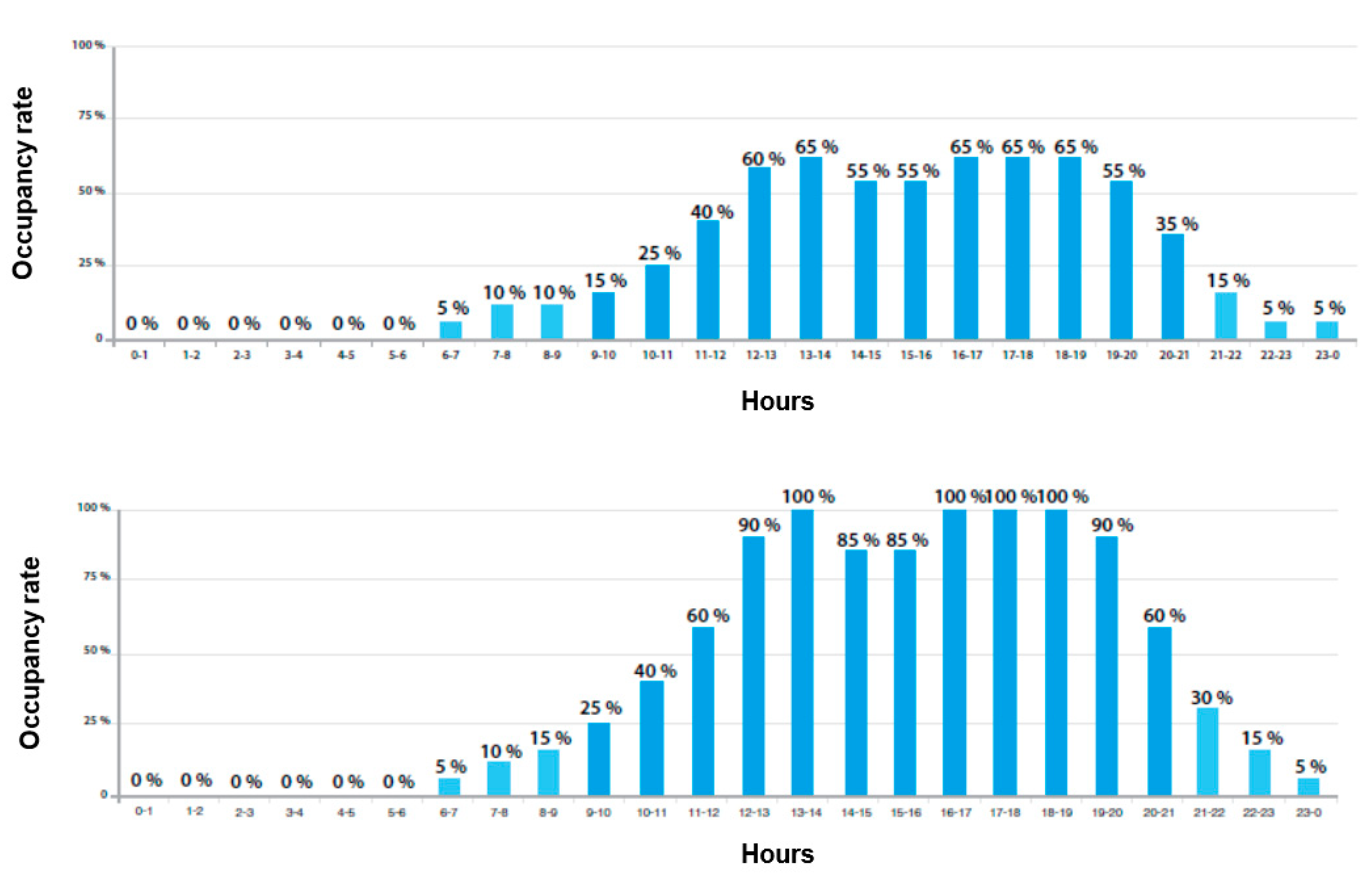
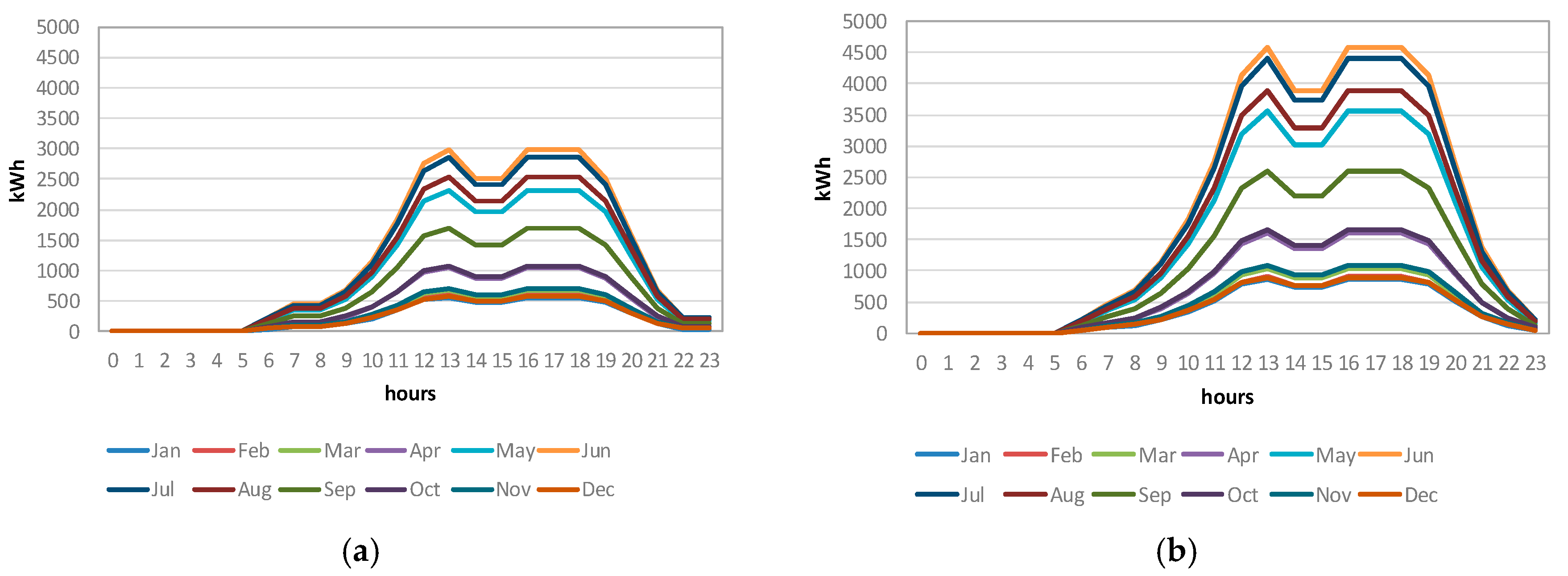
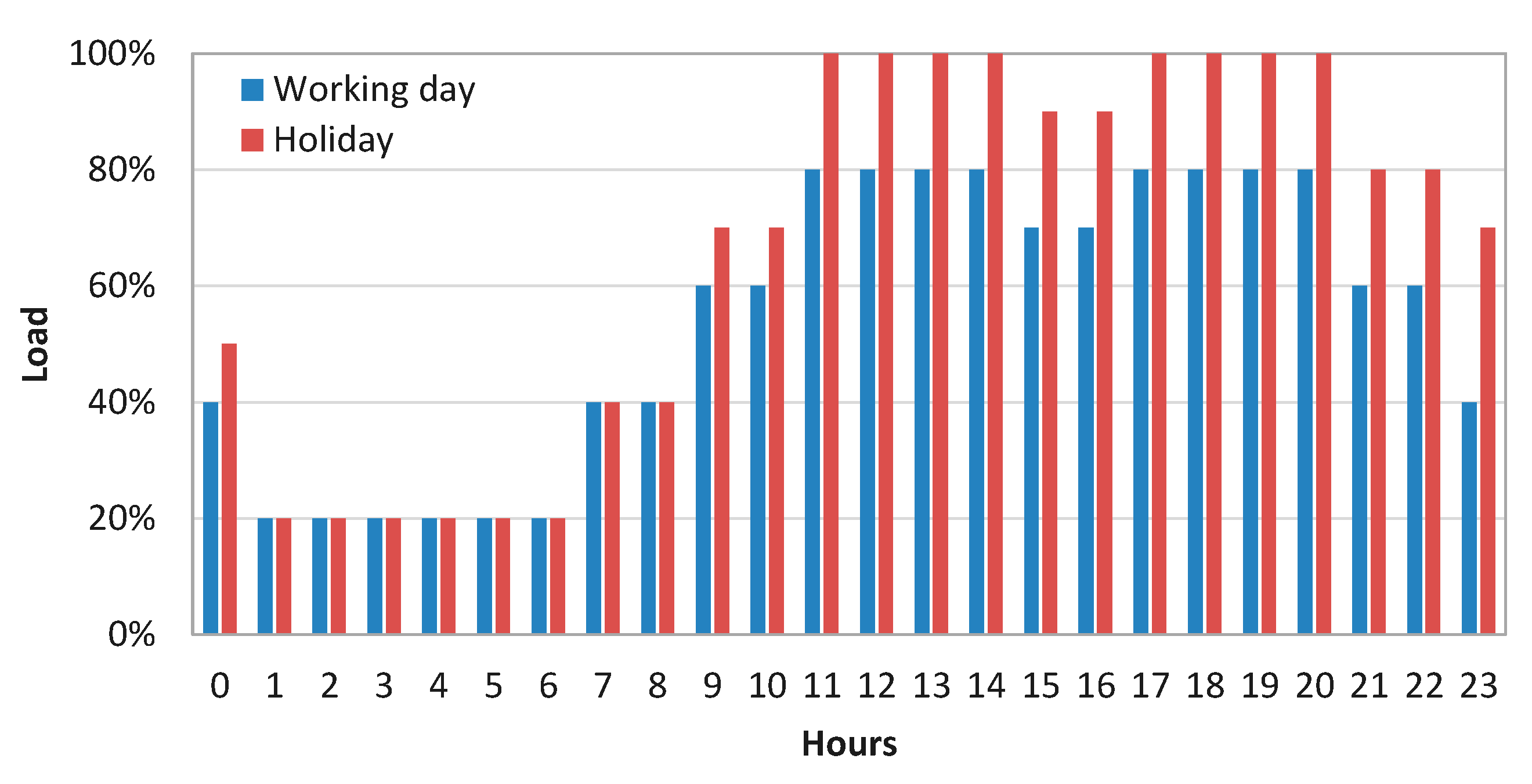
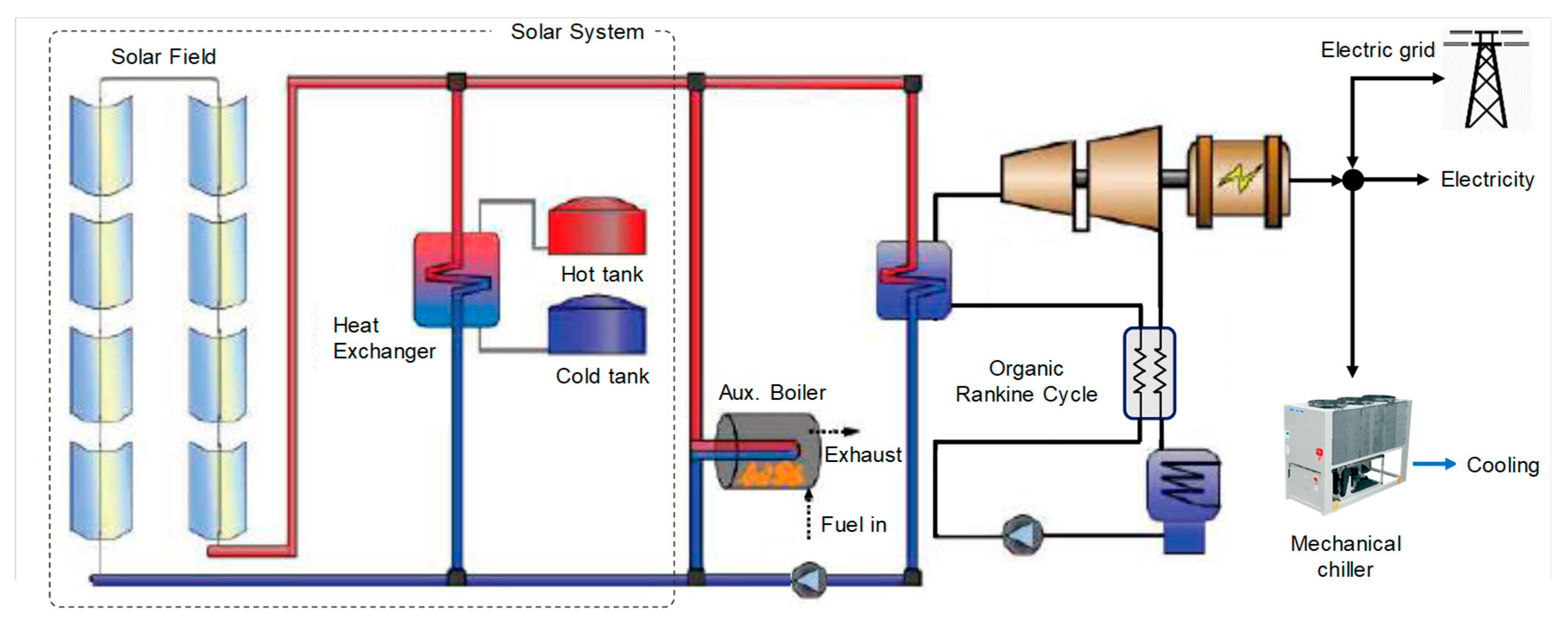
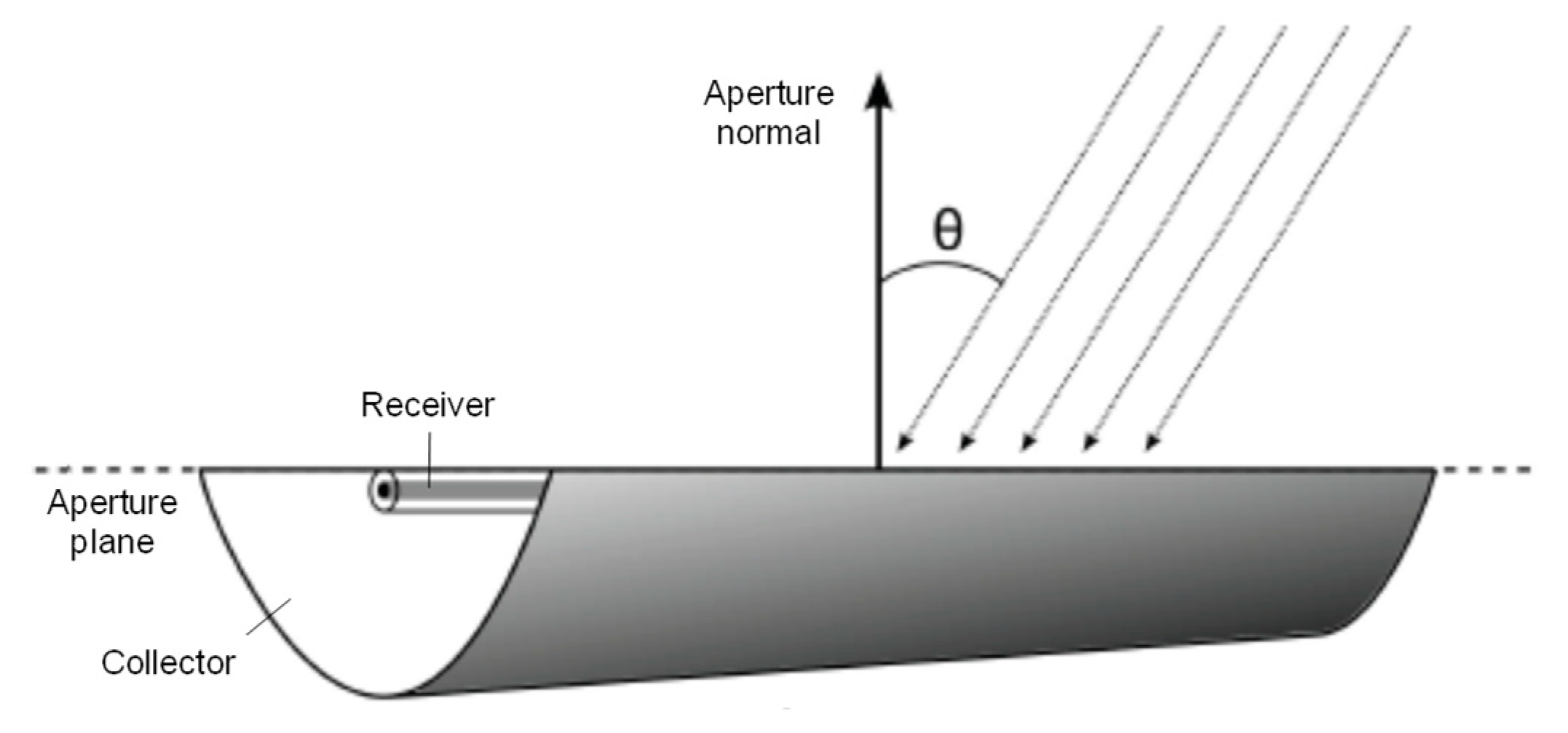

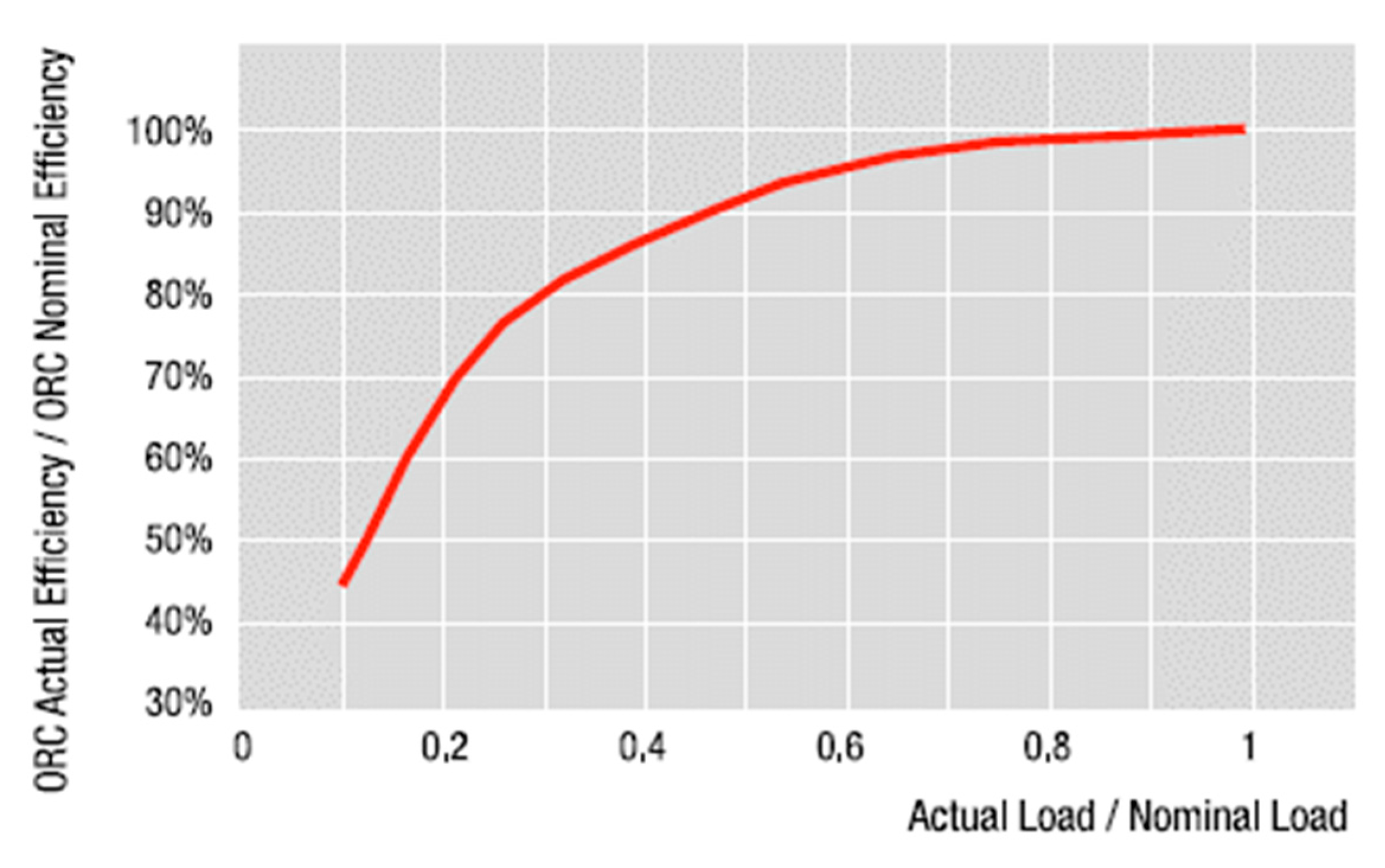


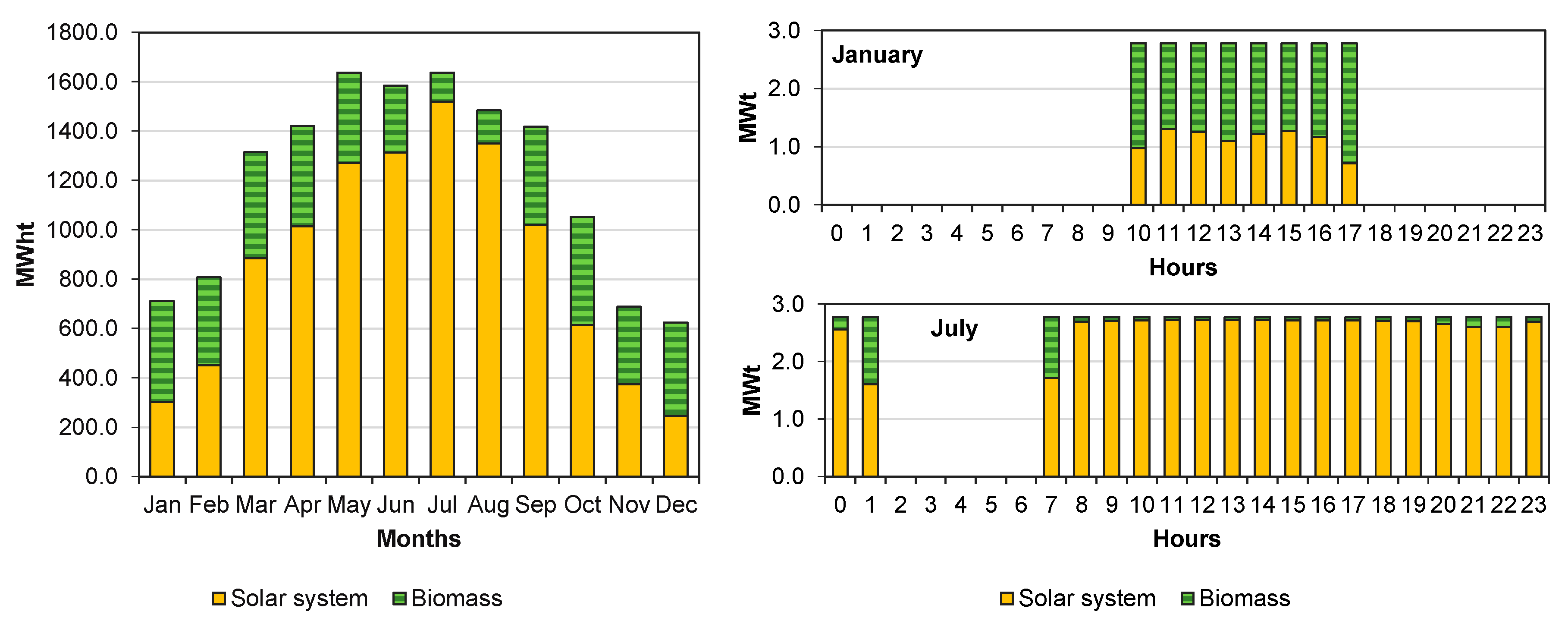
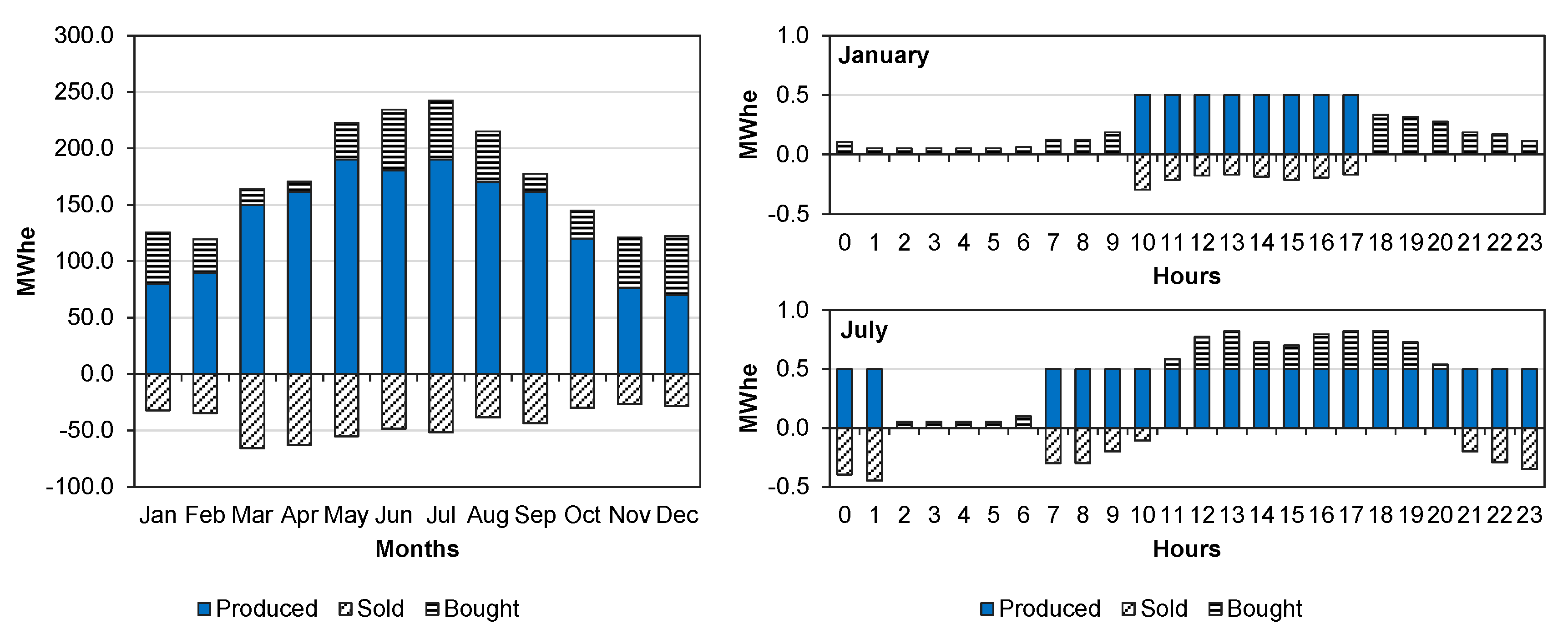
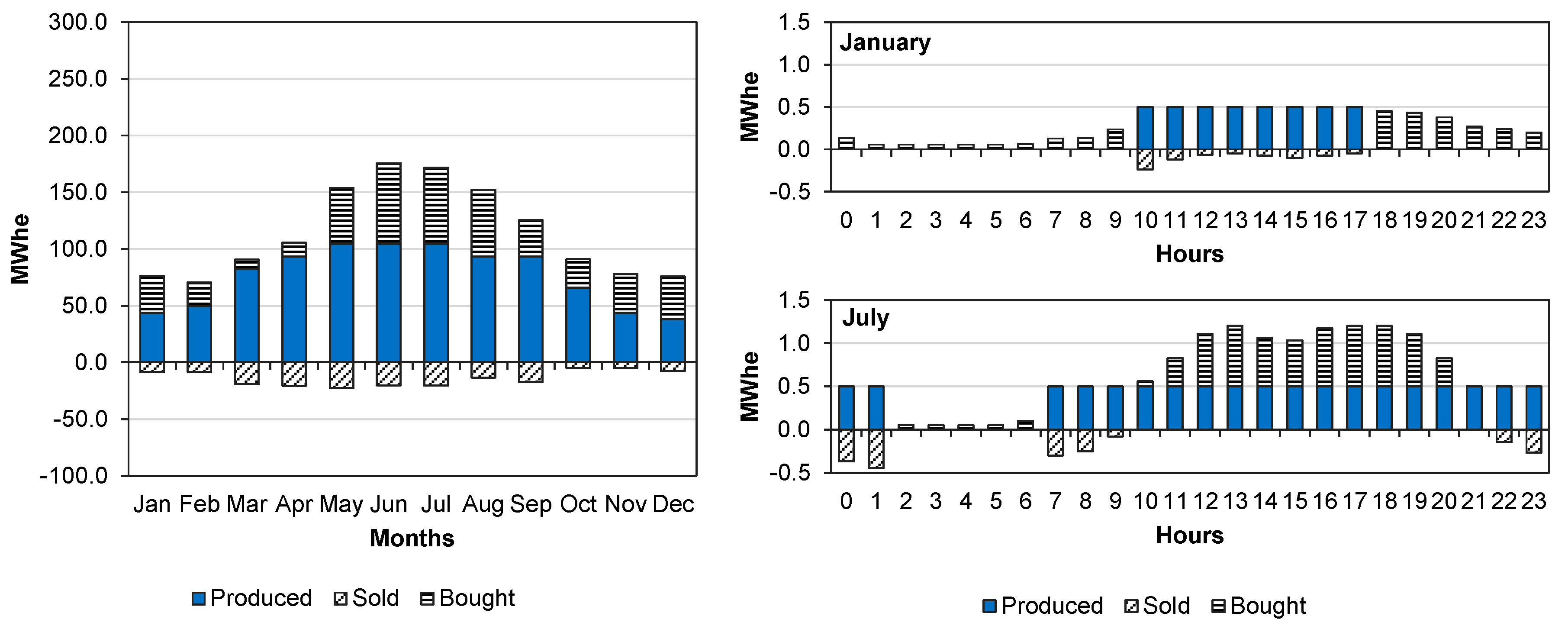

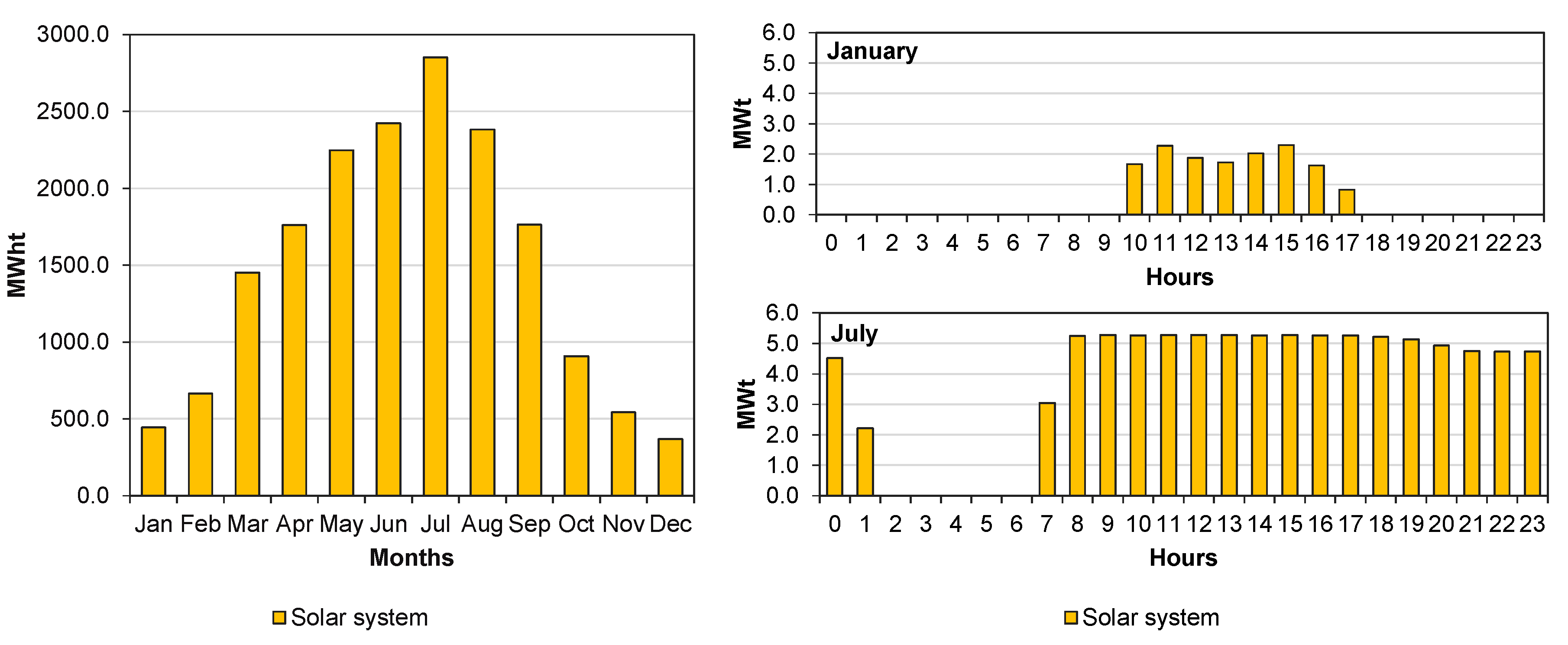
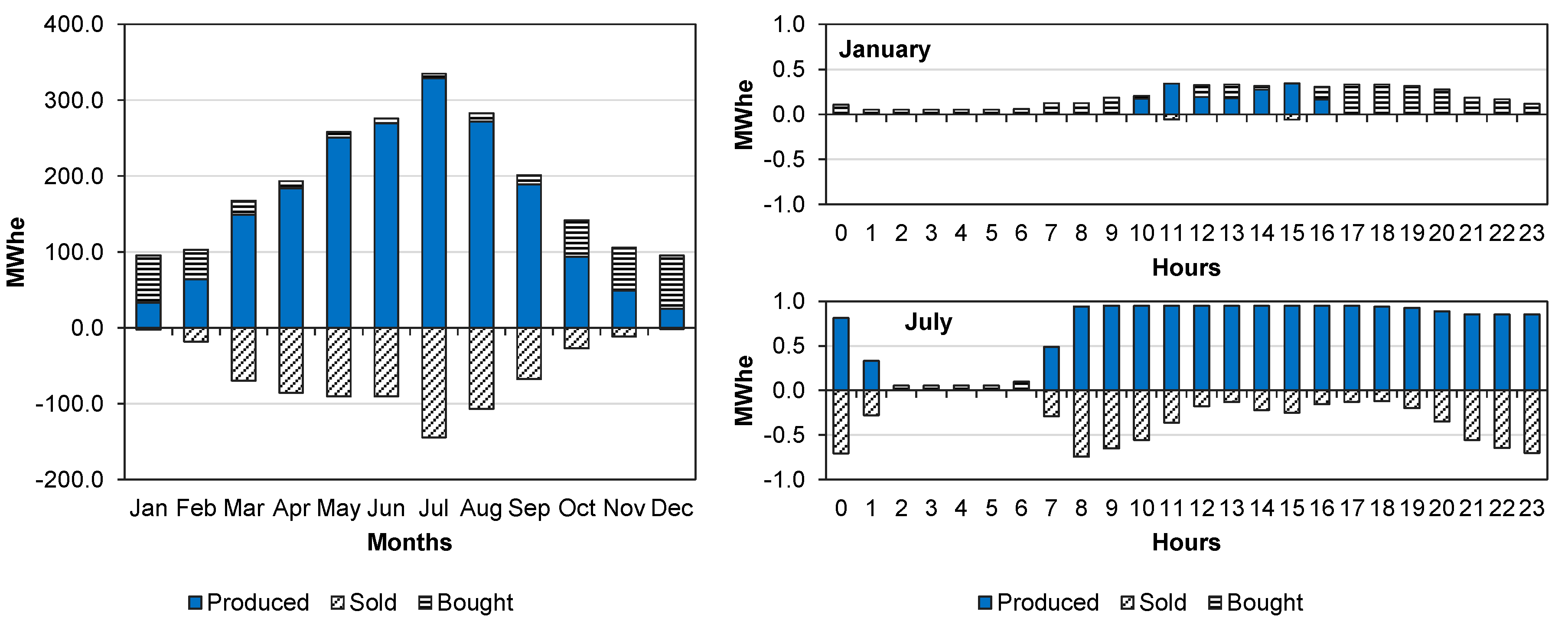
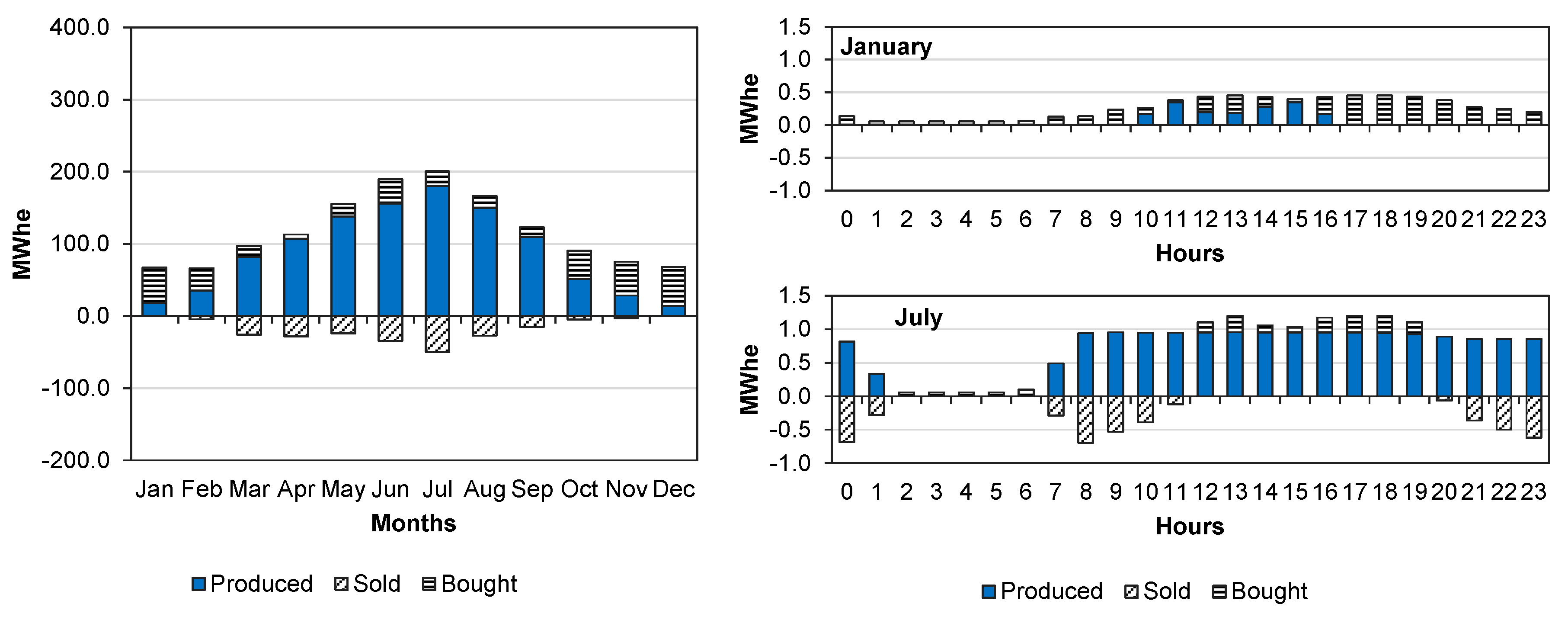
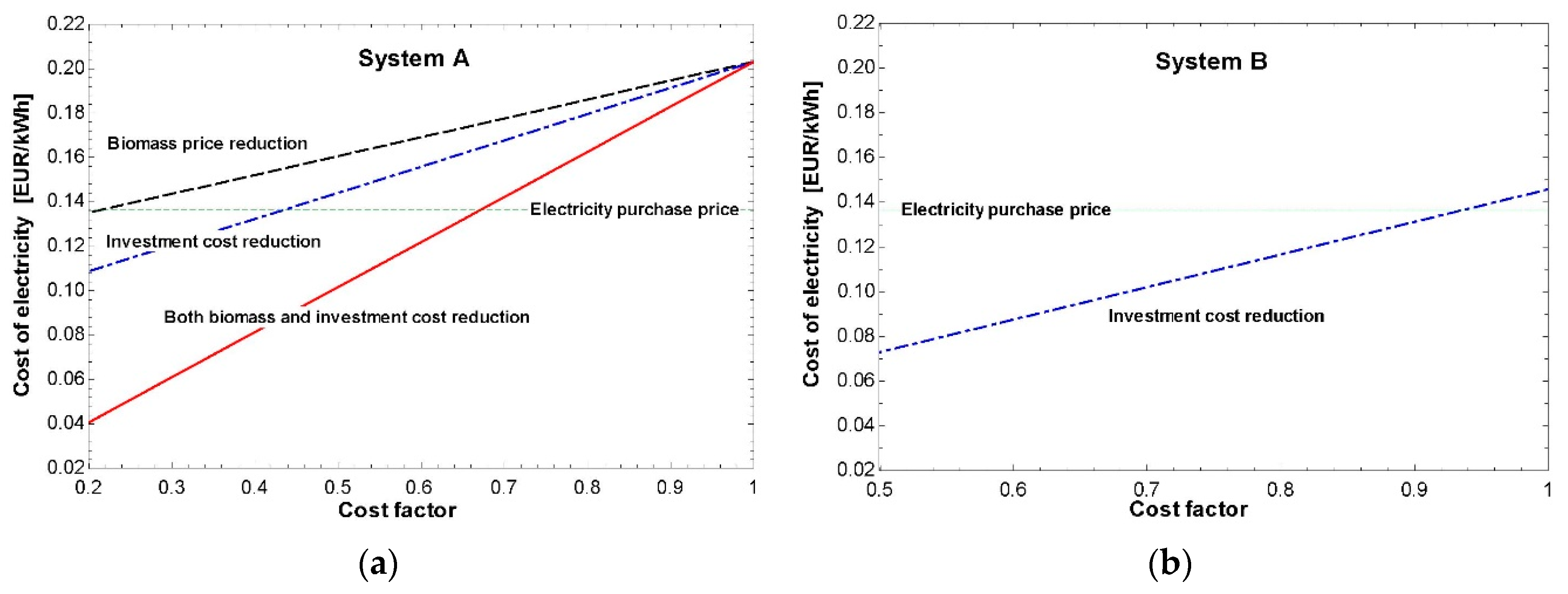
| Flow | Jan | Feb | Mar | Apr | May | Jun | Jul | Aug | Sep | Oct | Nov | Dec |
|---|---|---|---|---|---|---|---|---|---|---|---|---|
| 1 | 651 | 847 | 1630 | 1943 | 2493 | 2666 | 3200 | 2567 | 1955 | 1117 | 767 | 567 |
| 2 | 280 | 423 | 863 | 1011 | 1272 | 1314 | 1519 | 1331 | 1019 | 596 | 352 | 226 |
| 3 | 410 | 356 | 430 | 407 | 366 | 271 | 119 | 134 | 399 | 438 | 315 | 377 |
| 4 | 689 | 778 | 1292 | 1417 | 1637 | 1584 | 1637 | 1465 | 1417 | 1034 | 667 | 603 |
| 5 | 124 | 140 | 232 | 255 | 294 | 285 | 294 | 263 | 255 | 186 | 120 | 109 |
| 6 | 44 | 42 | 53 | 80 | 182 | 229 | 225 | 199 | 129 | 85 | 54 | 46 |
| 7 | 116 | 105 | 116 | 113 | 116 | 113 | 116 | 116 | 113 | 116 | 113 | 116 |
| 8 | 161 | 147 | 169 | 193 | 299 | 341 | 342 | 315 | 242 | 201 | 167 | 162 |
| 9 | 83 | 97 | 147 | 171 | 217 | 216 | 222 | 212 | 194 | 151 | 88 | 72 |
| 10 | 78 | 50 | 22 | 21 | 82 | 125 | 119 | 104 | 48 | 50 | 79 | 90 |
| 11 | 41 | 43 | 85 | 84 | 78 | 69 | 72 | 52 | 61 | 35 | 32 | 36 |
| 12 | 208 | 196 | 249 | 374 | 854 | 1070 | 1055 | 932 | 606 | 397 | 254 | 214 |
| 13 | 500 | 434 | 524 | 496 | 446 | 331 | 145 | 164 | 486 | 535 | 385 | 460 |
| Flow | Jan | Feb | Mar | Apr | May | Jun | Jul | Aug | Sep | Oct | Nov | Dec |
|---|---|---|---|---|---|---|---|---|---|---|---|---|
| 1 | 842 | 1095 | 2109 | 2514 | 3225 | 3449 | 4140 | 3321 | 2529 | 1445 | 992 | 733 |
| 2 | 443 | 665 | 1453 | 1761 | 2246 | 2422 | 2851 | 2382 | 1763 | 908 | 542 | 368 |
| 5 | 52 | 100 | 231 | 291 | 389 | 425 | 509 | 421 | 299 | 145 | 78 | 39 |
| 6 | 44 | 42 | 53 | 80 | 182 | 229 | 225 | 199 | 129 | 85 | 54 | 46 |
| 7 | 116 | 105 | 116 | 113 | 116 | 113 | 116 | 116 | 113 | 116 | 113 | 116 |
| 8 | 161 | 147 | 169 | 193 | 299 | 341 | 342 | 315 | 242 | 201 | 167 | 162 |
| 9 | 49 | 77 | 136 | 177 | 274 | 300 | 315 | 288 | 217 | 114 | 64 | 38 |
| 10 | 111 | 70 | 34 | 15 | 25 | 41 | 26 | 28 | 25 | 87 | 103 | 124 |
| 11 | 2 | 22 | 95 | 114 | 115 | 125 | 194 | 134 | 82 | 32 | 14 | 1 |
| 12 | 208 | 196 | 249 | 374 | 854 | 1070 | 1055 | 932 | 606 | 397 | 254 | 214 |
| Hour | Jan | Feb | Mar | Apr | May | Jun | Jul | Aug | Sep | Oct | Nov | Dec |
|---|---|---|---|---|---|---|---|---|---|---|---|---|
| 00 | 0.00 | 0.00 | 0.00 | 1.17 | 2.06 | 3.50 | 4.52 | 2.36 | 0.00 | 0.00 | 0.00 | 0.00 |
| 01 | 0.00 | 0.00 | 0.00 | 0.00 | 0.74 | 1.76 | 2.21 | 0.00 | 0.00 | 0.00 | 0.00 | 0.00 |
| 02 | 0.00 | 0.00 | 0.00 | 0.00 | 0.00 | 0.00 | 0.00 | 0.00 | 0.00 | 0.00 | 0.00 | 0.00 |
| 03 | 0.00 | 0.00 | 0.00 | 0.00 | 0.00 | 0.00 | 0.00 | 0.00 | 0.00 | 0.00 | 0.00 | 0.00 |
| 04 | 0.00 | 0.00 | 0.00 | 0.00 | 0.00 | 0.00 | 0.00 | 0.00 | 0.00 | 0.00 | 0.00 | 0.00 |
| 05 | 0.00 | 0.00 | 0.00 | 0.00 | 0.00 | 0.00 | 0.00 | 0.00 | 0.00 | 0.00 | 0.00 | 0.00 |
| 06 | 0.00 | 0.00 | 0.00 | 0.00 | 0.00 | 0.00 | 0.00 | 0.00 | 0.00 | 0.00 | 0.00 | 0.00 |
| 07 | 0.00 | 0.00 | 0.00 | 0.00 | 2.54 | 3.31 | 3.04 | 0.00 | 0.00 | 0.00 | 0.00 | 0.00 |
| 08 | 0.00 | 0.00 | 0.52 | 3.55 | 4.35 | 4.64 | 5.24 | 4.39 | 2.43 | 0.00 | 0.00 | 0.00 |
| 09 | 0.00 | 0.00 | 3.58 | 4.17 | 4.48 | 4.90 | 5.28 | 4.94 | 4.16 | 2.41 | 0.00 | 0.00 |
| 10 | 1.67 | 2.28 | 4.22 | 4.25 | 4.70 | 4.95 | 5.27 | 4.95 | 4.23 | 3.26 | 2.60 | 1.33 |
| 11 | 2.27 | 2.50 | 4.00 | 4.18 | 4.68 | 4.87 | 5.27 | 5.05 | 4.27 | 3.21 | 2.54 | 1.73 |
| 12 | 1.87 | 2.58 | 3.92 | 4.21 | 4.70 | 4.85 | 5.27 | 5.11 | 4.34 | 3.24 | 2.25 | 1.41 |
| 13 | 1.73 | 2.55 | 3.77 | 4.27 | 4.80 | 4.88 | 5.28 | 5.13 | 4.55 | 3.42 | 2.18 | 1.33 |
| 14 | 2.02 | 3.00 | 4.12 | 4.36 | 4.57 | 4.81 | 5.26 | 5.12 | 4.43 | 3.47 | 2.67 | 1.85 |
| 15 | 2.30 | 3.18 | 4.04 | 4.20 | 4.54 | 4.79 | 5.27 | 5.10 | 4.57 | 3.51 | 3.39 | 2.41 |
| 16 | 1.62 | 3.57 | 3.93 | 4.05 | 4.47 | 4.68 | 5.27 | 5.14 | 4.63 | 3.33 | 1.53 | 1.06 |
| 17 | 0.82 | 2.33 | 3.83 | 3.78 | 4.49 | 4.55 | 5.27 | 5.16 | 4.24 | 2.19 | 0.89 | 0.73 |
| 18 | 0.00 | 1.22 | 3.00 | 3.47 | 4.47 | 4.56 | 5.21 | 5.03 | 3.74 | 1.25 | 0.00 | 0.00 |
| 19 | 0.00 | 0.54 | 2.47 | 3.24 | 4.36 | 4.37 | 5.14 | 4.95 | 3.43 | 0.00 | 0.00 | 0.00 |
| 20 | 0.00 | 0.00 | 1.91 | 2.90 | 3.96 | 4.04 | 4.93 | 4.18 | 2.99 | 0.00 | 0.00 | 0.00 |
| 21 | 0.00 | 0.00 | 1.58 | 2.60 | 3.11 | 3.86 | 4.75 | 3.63 | 2.70 | 0.00 | 0.00 | 0.00 |
| 22 | 0.00 | 0.00 | 1.23 | 2.40 | 2.80 | 3.80 | 4.73 | 3.38 | 2.19 | 0.00 | 0.00 | 0.00 |
| 23 | 0.00 | 0.00 | 0.75 | 1.90 | 2.63 | 3.62 | 4.74 | 3.21 | 1.86 | 0.00 | 0.00 | 0.00 |
| Economic Analysis | ||||||||||
| Technology | Unit Investment Cost | Conventional System | System A | System B | ||||||
| Capacity | Investment Cost (EUR) | Annual Inv. Cost (EUR/year) | Capacity | Investment Cost (EUR) | Annual Inv. Cost (EUR/Year) | Capacity | Investment Cost (EUR) | Annual Inv. Cost (EUR/Year) | ||
| Solar Field | 235 (EUR/m2) [64] | - | - | - | 13,080 (m2) | 3,073,800 | 153,690 | 19,620 (m2) | 4,610,700 | 230,535 |
| TES | 65 (EUR/kWht) [64] | - | - | - | 16,700 (kWh) | 1,085,500 | 54,275 | 32,600 (kWh) | 2,119,000 | 105,950 |
| Biomass boiler | 315 (EUR/kWt) [57] | - | - | - | 2800 (kWt) | 882,000 | 44,100 | - | - | - |
| ORC | 2000 (EUR/kWe) [65,66] | - | - | - | 500 (kWe) | 1,000,000 | 50,000 | 978 (kWe) | 1,956,000 | 97,800 |
| Chillers | 180 (EUR/kWt) [67] | 4581 (kWt) | 824,580 | 41,229 | 4581 (kWt) | 824,580 | 41,229 | 4581 (kWt) | 824,580 | 41,229 |
| Total investment cost/Total annual investment cost | 824,580 (EUR) | 41,229 (EUR/year) | 6,865,880 (EUR) | 343,294 (EUR/year) | 9,510,280 (EUR) | 475,514 (EUR/year) | ||||
| Energy service | Unit energy cost (EUR/kWh) | Annual energy (MWh/year) | Annual energy cost (EUR/year) | Annual energy (MWh/year) | Annual energy cost (EUR/year) | Annual energy (MWh/year) | Annual energy cost (EUR/year) | |||
| Electricity bought | 0.1363 [68] | 2740 | 373,462 | 867 | 118,172 | 690 | 94,047 | |||
| Electricity sold | −0.0682 | - | - | 687 | −46,853 | 930 | −63,426 | |||
| Biomass pellets | 0.0444 [69] | - | - | 4904 | 217,738 | - | - | |||
| Total annual energy cost | 373,462 (EUR/year) | 289,056 (EUR/year) | 30,621 (EUR/year) | |||||||
| Total annual cost | 414,691 (EUR/year) | 632,350 (EUR/year) | 506,135 (EUR/year) | |||||||
| Environmental Analysis | ||||||||||
| Energy Service | Unit CO2 Emissions (kgCO2/kWh) | Unit primary Energy (Non-Renew.) (kWh/kWh) | Conventional System | System A | System B | |||||
| Annual CO2 Emissions (kgCO2/Year) | Annual Primary Energy (Non-Renew.) (kWh/year) | Annual CO2 Emissions (kgCO2/Year) | Annual Primary Energy (Non-Renew.) (kWh/Year) | Annual CO2 Emissions (kgCO2/Year) | Annual Primary Energy (Non-Renew.) (kWh/Year) | |||||
| Electricity bought | 0.331 [70] | 1.954 [70] | 906,940 | 5,353,960 | 286,977 | 1,694,118 | 228,390 | 1,348,260 | ||
| Electricity sold | −0.331 | −1.954 | ------ | ------ | −227,397 | −1,342,398 | −307,830 | −1,817,220 | ||
| Biomass pellets | 0.018 [70] | 0.085 [70] | ------ | ------ | 88,272 | 416,840 | ------ | ------ | ||
| Total annual CO2 emissions/non-renewable primary energy | 906,940 (kgCO2/year) | 5,353,960 (kWh/year) | 147,852 (kgCO2/year) | 768,560 (kWh/year) | −79,440 (kgCO2/year) | −468,960 (kWh/year) | ||||
© 2020 by the authors. Licensee MDPI, Basel, Switzerland. This article is an open access article distributed under the terms and conditions of the Creative Commons Attribution (CC BY) license (http://creativecommons.org/licenses/by/4.0/).
Share and Cite
Pina, E.A.; Serra, L.M.; Lozano, M.A.; Hernández, A.; Lázaro, A. Comparative Analysis and Design of a Solar-Based Parabolic Trough–ORC Cogeneration Plant for a Commercial Center. Energies 2020, 13, 4807. https://doi.org/10.3390/en13184807
Pina EA, Serra LM, Lozano MA, Hernández A, Lázaro A. Comparative Analysis and Design of a Solar-Based Parabolic Trough–ORC Cogeneration Plant for a Commercial Center. Energies. 2020; 13(18):4807. https://doi.org/10.3390/en13184807
Chicago/Turabian StylePina, Eduardo A., Luis M. Serra, Miguel A. Lozano, Adrián Hernández, and Ana Lázaro. 2020. "Comparative Analysis and Design of a Solar-Based Parabolic Trough–ORC Cogeneration Plant for a Commercial Center" Energies 13, no. 18: 4807. https://doi.org/10.3390/en13184807
APA StylePina, E. A., Serra, L. M., Lozano, M. A., Hernández, A., & Lázaro, A. (2020). Comparative Analysis and Design of a Solar-Based Parabolic Trough–ORC Cogeneration Plant for a Commercial Center. Energies, 13(18), 4807. https://doi.org/10.3390/en13184807






